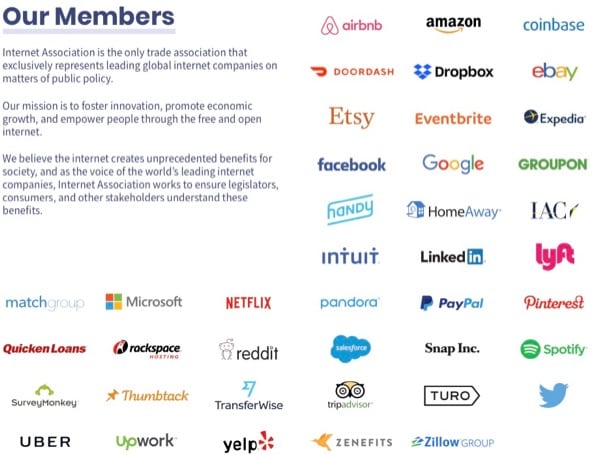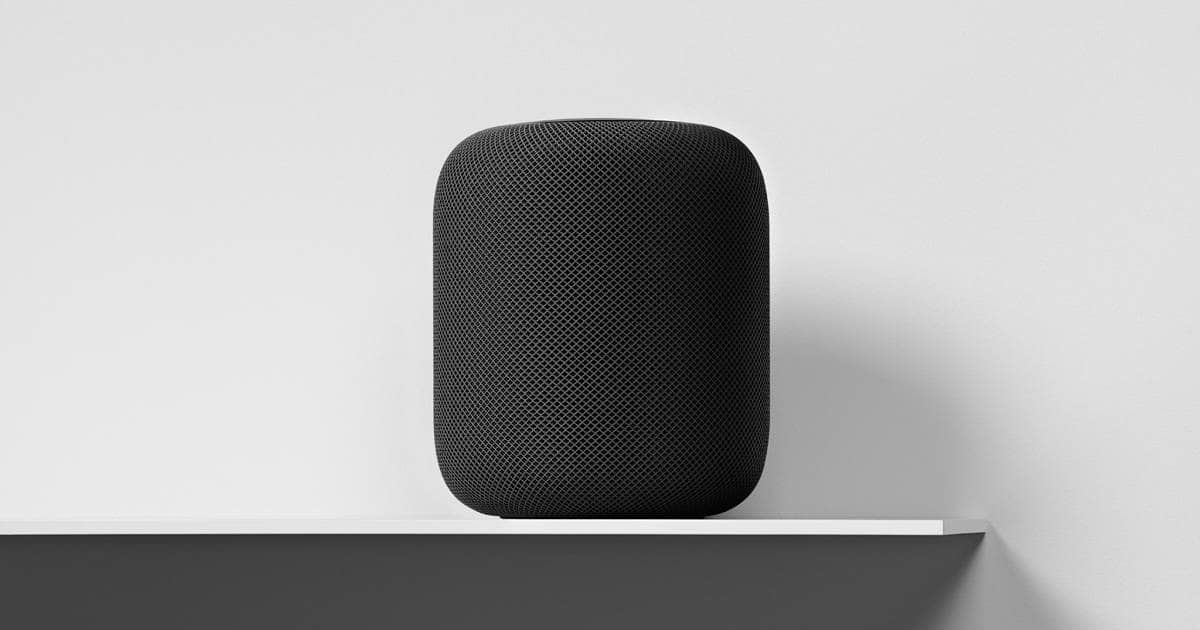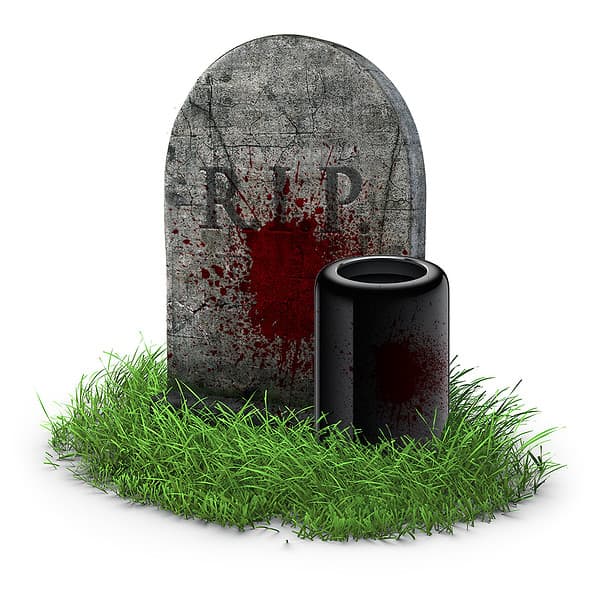The Fight For Net Neutrality Accelerates, Invokes New Tactics
The recent FCC ruling that undermines the concept of net neutrality isn’t the final say as new political and tactical countermeasures gain momentum.

Two articles this week spell out the very positive prospects in the fight to preserve net neutrality.
- Internet Association pressures Senate to reverse FCC’s net neutrality repeal.
- This crafty tactic may let states get around the FCC on net neutrality
In the first article, Digital Trends reports how the powerful and influential Internet Association is putting significant pressure on the U.S. Senate to reverse the FCC’s ruling that undermines net neutrality.

Internet Association members.
The Internet Association is a trade association that represents its many member companies on matters of public policy. Members include Amazon, Facebook, Google, Microsoft and Netflix to name a few. (But not Apple for some reason.)
Digital Trends writes:
In an open letter to Senate Majority Leader Mitch McConnell, R-Ky.,and Minority Leader Charles Schumer, D-N.Y., the IA argues that a free and open internet is to the benefit of all users, and that the net neutrality rules need to stay in place to combat the ruthless monopoly held by broadband providers in many areas.
This effort has more weight than it seems because it is supported by other internet technology leaders, the Electronic Frontier Foundation (EFF) and the American Civil Liberties Union (ACLU), according to Ernesto Falcon of the EFF.
The Hill reports that a bill to overturn the FCC’s decision has garnered the support of the entire Democratic party and a single Republican senator. This means that only one more Republican senator is needed to push the bill through.
In the second article above, from the Washington Post, a few states are taking an interesting business and legal approach. If a company wants to do business in California, Hawaii, New Jersey, New York, or Montana, it will have to abide by net neutrality rules. From WaPo:
New Jersey Gov. Phil Murphy (D) this week became one of the latest to adopt the strategy, signing an executive order that effectively forces Internet service providers (ISPs) that do business with the state to abide by strong net neutrality rules.
Rather than directly regulating the broadband industry, the executive order imposes procurement obligations on state agencies. Under the order, state officials contracting with ISPs for service may only do so if the providers agree not to block or slow websites, or to offer websites faster delivery to consumers in exchange for an extra fee.
Questions have been raised about the prospects for success with this tactic, but it does demonstrate that several states that are looking out for the best interests of their citizens and local corporations are developing remedial strategies. Even if those don’t succeed, it could set the stage, I surmise, for new approaches in concert with the Internet Association.
The bottom line is that while net neutrality seems to have taken a short-term hit for political purposes, several powerful organizations and states are effectively fighting back.
Tune into our Background Mode podcast on February 12 to hear the EFF’s Legislative Counsel, Ernesto Falcon, fill in the details of the fight to restore net neutrality.
Next Page: The News Debris For The Week of February 5th. Sizing up the HomePod.
Page 2 – News Debris For The Week of February 5th
Sizing up the HomePod

Image credit: Apple
• The responses to the HomePod seem to be coming from the personal perspectives of the authors. If one is outside (or disfavors) the Apple ecosystem, then the HomePod seems to be an alien pet that doesn’t play well with the family cats. For example, “The HomePod is the point of no return for Apple fans.” The subtitle reveals more nuance. “This speaker is openly hostile to any hardware or service not made by Apple.”
Moving on. An author firmly in the Apple camp, Michael Gartenberg, ponders the AI aspects and market positioning of the HomePod. “HomePod in the age of Artificial Intelligence.” Many questions are posed.
I have no doubt that AI growth in the home, mostly through connected speakers, is going to explode this year. But several questions remain. Will users stay in their phone and tablet ecosystem and services or will they be swayed by other features that are platform neutral or cross-platform, such as devices that support Spotify as a third party service, can handle the basic tasks that users want, such as time, weather and news. Will hardware features such as high-end audio drive purchases?
Jonny Evans, also firmly pro-Apple, with his usual thoroughness, looks at some of the key design elements and features that others often overlook. In this case, collaboration. “How can Apple’s HomePod stake space in the enterprise?”
In the final analysis, sales will depend on how Apple’s mainstream customers size it up as the product is intended to be. When all is said and done, journalist opinions about the product will soon be forgotten.
More Debris
• If you’ve been gazing into your crystal ball, trying to figure out what might be in store for Apple’s next Mac Pro, I recommend this missive. “What can we expect from the new Mac Pro in 2018?” The author presents the entire Mac Pro history, issues with technical and creative professionals, the story of the 2013 Mac Pro, what Apple promised in terms of the future timeline, and some discussion of potential, future Mac Pro technologies. This is a must read for all techies.
Related

• Here’s another forward-looking article. “Apple Prepping New Coprocessors, Macs, iPad for Later This Year.” It opens with:
Apple’s CPU design chops and its willingness to tackle custom silicon work have created an odd situation in computing — one in which the coprocessors the company designs into its products are now treated as major announcements in and of themselves. It’s a baffling, Apple-specific treatment of coprocessors that likely leaves the company’s competitors in fits.
If you’re hungry for more, dig into this one.
• Finally, some pundits have suggested that the fate of the HomePod can be analyzed in light of the track record of the Apple Watch. That is, as the product hits the field and customers start to really utilize and understand it for what it is, sales start to build momentum. Before you know it, the product is an amazing success all out of proportion to any sour notes at launch.
For some perspective on that, here’s a report by Canalys on the sales of the Apple Watch to date. “18 million Apple Watches ship in 2017, up 54% on 2016.” Following this example, we should plan to look at HomePod sales not in February, 2018, but rather for the whole year of 2019.
Patience is called for. But patience doesn’t produce click-bait headlines of doom.
Particle Debris is a generally a mix of John Martellaro’s observations and opinions about a standout event or article of the week (preamble on page one) followed on page two by a discussion of articles that didn’t make the TMO headlines, the technical news debris. The column is published most every Friday except for holiday weeks.


0 Response to "The Fight For Net Neutrality Accelerates, Invokes New Tactics"
Post a Comment